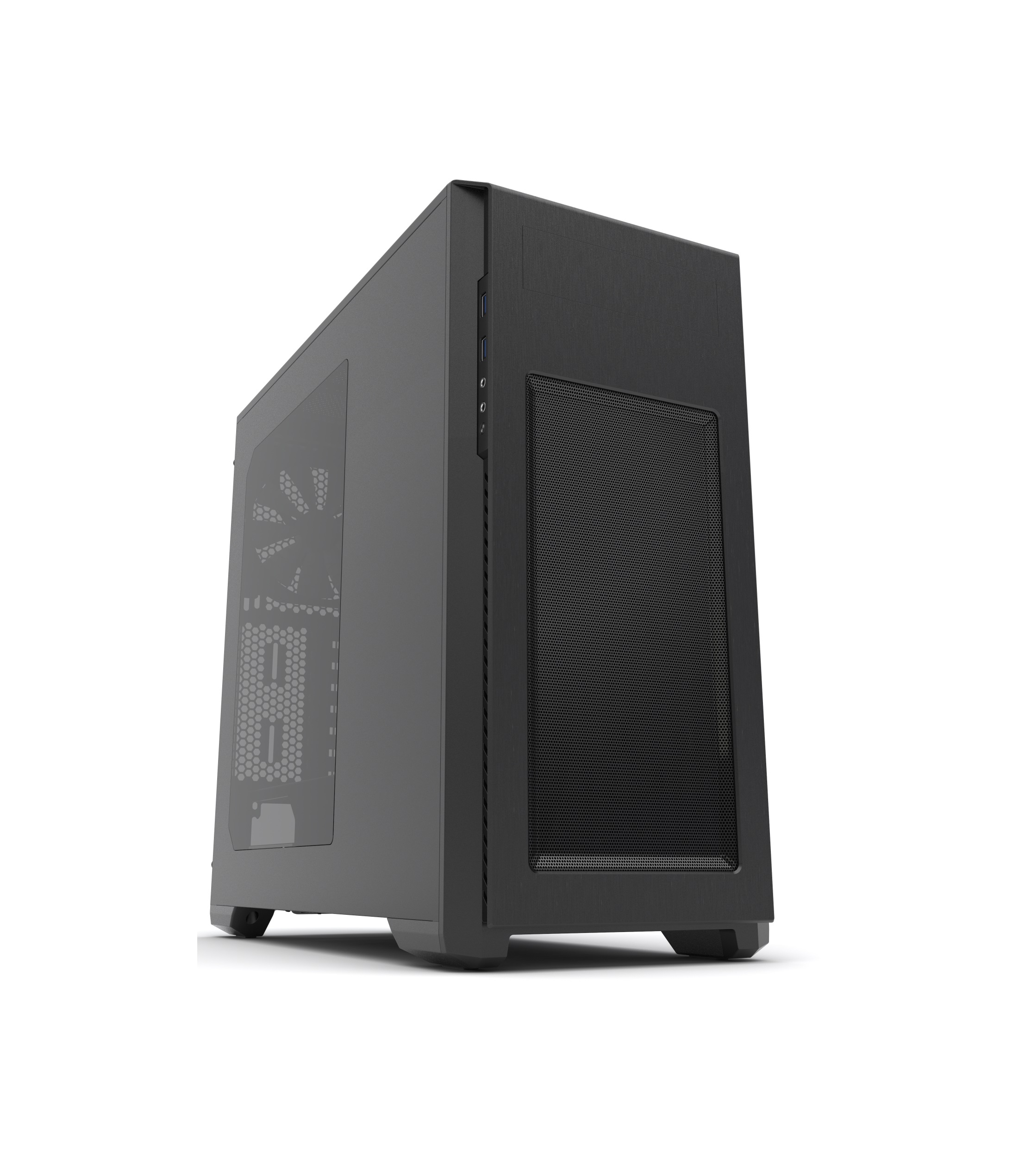
Today we are reviewing a product from one of the hottest brands at the moment in computer cases - The Enthoo Pro M from Phanteks.
It’s a budget PC case , basically it’s a junior version of the Enthoo Pro. Thus the Pro M (M for mid-tower) is a hybrid of the Pro and the recent Enthoo ATX, with a number of changes to keep the price as low and more attractive as possible.
First, about Phanteks:
Phanteks was founded from a group of engineers with a total of 20 years of international experience in thermal solutions. They paired up with a Dutch design team and established Phanteks in 2007. Then they ventured into the CPU cooling industry with two goals in mind, “High-end quality and innovative products in thermal solutions.”
As a relatively young company, Phanteks strives to develop top quality and superior products. The first product, PH-TC14PE, was a great success in the overclocking community. With the success made, the passionate in developing new and better innovative cooling solutions was greater than ever. Phanteks Design Team is situated in the Netherlands and consists of creative researchers, designers and developers whose only desires are to bring the latest cutting edge technology to you.
Remaining focused on the PC enthusiast, Phanteks released their first line of computer cases, the Enthoo Series. The Enthoo series offers the watercooling community features not available from most other manufacturers. Phanteks will continuously pursue excellence in developing new products to bring satisfaction to PC enthusiasts and computer users everywhere.
Their goal is to be the best in the industry in all that we do and our motto is “no job is impossible.”
Price when reviewed : £ 59.99 - Via Scan.co.uk
Phanteks Enthoo PRO M w/ Window Satin Black
Specifications
- Dimensions (mm): 235 x 500 x 480 (W x D x H)
- Material: steel, plastic
- Available colours: Satin Black / Titanium Green
- Weight: 7.4kg
- Front panel: Power, reset, 2 x USB 3, stereo, microphone
- Drive bays: 1x external 5.25″, 2x 3.5″/2.5:”, 1x 2.5″ (extra 6 x 3.5i”/2.5″ and 2x 2.5′ drives supported via extra brackets purchased separately)
- Form factor(s): E-ATX (up to 264mm wide), ATX, micro-ATX, mini-ITX
- Cooling: 1x 140mm/120mm rear fan mount (140mm PH-F140SP fan included), 3x 120mm or 2x 140mm front fan mounts, 3x 120mm or 2x 140mm roof fan mounts (fans not included)
- CPU cooler clearance: 194mm
- Maximum graphics card length: 420mm (300mm with HDD bracket installed)
- Extras: Removable dust filters, integrated pump and reservoir mounts, acrylic window version as well
Looking at these specs, we see the basis and the main structure from the more expensive Evolv ATX, minus of course some feature to market it very competitively.
The NZXT S320 is its prime rival.
Let’s see the Enthoo Pro M in action.
Packaging
On the main side we have a visual representation of the case along with the name.
On the side we have the specifications and product code.
Inside we see that it is well protected and sits confortably in the styrofoam pads.
Visual examination
And the case in all of its glory. Here we can see what it’s made off. Let’s analyse all the important parts.
Glad to see a protection cover on the side panel.
Regarding the front connectivity, we have 2x USB 3.0 , audio and microphone jacks and a reset button.
Then the front side we see the mesh and the single 5.25″ bay.
The top side holds the magnetic dust filter.
Flip it and we see the power supply’s removable dust filter and the 4 feet which are very sturdy in supporting the case. They also have rubberized pads for further vibration dampening and traction.
The exterior inspection concludes with the rear where we have the PSU opening, the 140 or 120 mm fan placement which are height adjustable and the 7 PCI-E slots.
And a very important one, the option to add a water pump in the area between the fan and PSU.
The side panels are a bit flimsy.
Let’s take the party inside.
At first glance it is full of real estate, optimized for airflow and liquid cooling versatility.
Focusing on this part we have:
- Large ventilated metal cover for the PSU with an opening for the PCI-E video cables
- Water pump fixtures
- Holding screws for 1x SSD mounting tray with the paired opening for the cables
Then the front cables for the I/O are are all black, nice to see the attention to details.
The case comes with most of the motherboards stand-offs pre-installed and we see the 140 mm Phanteks include fan.
The large PSU cutout with 4 rubberized securing pads.
The single 5.25″ bay and the removable bracket where you can install proprietary Phanteks 3.5″/2.5″ SSD/HDD cages - like bunked beds.
Removing the front panel shows us how well ventilated the case can be if you choose to install 3x 120 mm fans or 2x 140 mm fans. Not to mention the 240 mm waterblocks. Then the front I/O cables are well organised and routed.
Speaking of the panel, it hold the front removable and washable dust filter.
Let’s focus onto a very handy feature, the removable top tray which simplifies the installation processes of fans or radiators.
It is hold on by 4 screws, 2 on each side and are not colored for easy identification.
The plate has a multitude of mounting and adjusting options. Very very good.
Moving on the other side, again we see the attention to details and sense of responsibility.
Excellent feature that helps the wire management with the Velcro holding straps and plenty of space offered by the PSU cover plate.
Then the storage options, 1x SSD plate behind the motherboard with the option to add another one and the 2 removable trays for 3.5″ or 2.5″ SSD/HDD.
Nice touch to secure the accessory box in one of the trays.
It holds all the necessary screws, zip ties, a warranty card and an installation manual.
Zooming in at the motherboard cutout, which is very generous, we see the spot where a fan hub would have been. For cost reduction resons it is not present, among with the 2nd and front (3rd) SSD plate.
A lot of distance to route and tidy up any wires.
In the next part we will start the actual build.
The Build
We crammed as many components as we can to see if any compatibility issues will arise.
Hardware used:
- CPU: Intel Pentium G3258 at 4.3 Ghz @ 1.255v
- CPU Cooler: Reeven Okeanos Dual Tower
- Motherboard: ASUS Maximus Hero VI Z87
- Memory Modules: 8 GB (2x 4 GB) DDR3 Crucial Ballistix Tactical Tracers 1600 Mhz CL8
- PSU: Corsair TX 850W
- Video card: NVIDIA 8800 GTX / EVGA GTX 480
- Storage: 1x Samsung 840 Pro 128 GB / 2x Crucial BX200 240 GB
- Fan controller: Reeven Six Eyes II
- Fans:2x 140 mm Noiseblocker B14-1 + 2x 140 mm Noiseblocker B14-2
We start with the fans. The plate is doing its job marvelously.
The plate even has an offset so that the fans / radiators will not interfere with the motherboard.
Then on the front, we put 2 more fans. Excellent to see that they took into consideration so many scenarios like this one where the lower fan cools both the main chamber but also the HDD drive enclosures. You even have extra space to route the cables from the fans.
We secure the motherboard that also holds a large dual tower CPU cooler.
Our test fans are wider that regular 140 mm fans and still no problems of clearance, although it was on the limit.
So far so good.
In the front we put a fan controller to spice things up a little because it adds so many wires to the equation.
Then the power supply goes in. We chose a non modular one specifically to test the wire management capabilities of the case.
This medusa spaghetti junction, with some patience, becomes this:
One SSD on the front or two on the back, after we got the second and third mounting plates.
And the finished build.
Testing
When everything is fitted let’s see how it handles the temperatures, airflow and noise output.
The following software was used to stress test the components.
Software:
- Windows 10 Pro x64 Build 1511.10586
- Intel Burn Test v2.54
- AIDA 64 Extreme Ed. v1.70
- Witcher 3 v1.10
Temperatures:
Room temperature: 20 degrees C.
CPU:
Idle: 28 C / Gaming Load: 51 C
GPU:
Idle: 37 C / Gaming load: 84 C
Noise:
We used our Pyle PSPL01 placed 45 cm away from the setup and the measured value is for the total noise of the build.
Idle: < 28 dB/A
Gaming load: ~ 35 dB/A
The case with our test setup handled everything without flaw.
Temperature wise if you choose the right parts you will get a lot of cooling power and low noise output.
The Phanteks Ethoo Pro M when it comes to noise, it did a marvelous job.
It handled even the obnoxious GTX 480, famed for its nuclear thermal and noise combo.
As for the wire management capabilities, is one of the easiest to work on, because of that plate that covers the PSU exactly where the cables start.
Then all the openings around the motherboard help a lot for a very clean build.
Again the famous architecture from the EVOLV it shows it’s great potential.
Conclusion
We had a great pleasure in reviewing this case from Phanteks which clearly, in our perspective, is the best buy option in this price range.
The good
- Superb inside construction and layout
- Epic quality and sturdiness
- Very good design
- Very good thermal and acoustic results
- Excels at airflow setup and watercooling versatility
- Included removable dust filters everywhere (even magnetic on the top side)
- The PSU cover for maximum wire management and looks
- Offers one of the most “idiot proof” wire management solutions
- Cable grommets very well placed
- The sliding top plate for ease of access and build
- Side windowed panel
- Excellent price
The bad
- If you want more storage options, you need to buy extra SSD/HDD brackets from Phanteks
- No fan hub, but all of these are understandable give the price range
- Side panel window is a little smaller than the more expensive brother
One of the most complete products out there in this price bracket.








